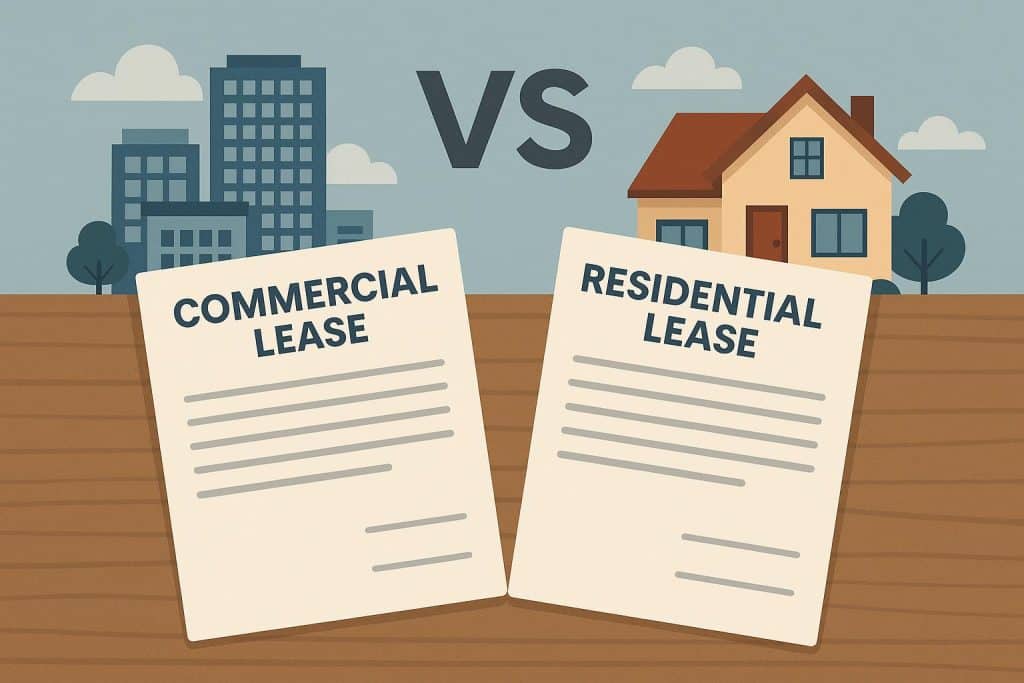Lease agreements play a critical role in defining the rights and responsibilities of both landlords and tenants. Whether you are renting a storefront for your business or moving into a new apartment, the type of lease you sign will shape your legal protections, financial obligations, and long-term expectations. The two most common types are commercial and residential lease agreements, and although they may appear similar at first glance, they serve very different purposes. Understanding what sets them apart can help renters make informed decisions and help landlords avoid future disputes.
Purpose and Use of the Property
The most obvious difference between commercial and residential leases lies in how the property will be used. A residential lease covers homes, apartments, or any living space intended for personal use. Its function is to provide a safe and habitable environment where an individual or family can reside. A commercial lease, on the other hand, is designed for business activity. This includes offices, retail shops, warehouses, restaurants, and other spaces where commercial operations take place. Because the purpose is profit-driven, commercial leases are often more complex and customizable.
The intended use affects not only the structure of the agreement but also the level of government regulation that applies. Residential leases are heavily regulated to protect tenants from unfair treatment, sudden evictions, or unsafe living conditions. Commercial leases usually offer fewer statutory protections because businesses are presumed to have more bargaining power and a better understanding of legal contracts.
Negotiation and Flexibility
Residential leases tend to follow a standard template with little room for negotiation. Most landlords expect tenants to accept the terms as presented, and changes to rent, security deposit requirements, or lease duration are limited. For example, a residential lease commonly lasts for twelve months, with the option to renew under similar terms.
Commercial leases offer significantly more flexibility. Rent price, lease length, maintenance responsibilities, renewal conditions, and even property improvements are all negotiable. Some commercial tenants may sign multi-year leases with percentage-based rent tied to business revenue, while others may negotiate tenant improvement allowances to customize the space. Because commercial tenants often invest heavily in building out a location, landlords also tend to negotiate longer lease periods to secure stable income.
Legal Protections and Responsibilities
Residential tenants benefit from a wide range of legal protections. Most jurisdictions require landlords to maintain a habitable environment, make timely repairs, follow strict eviction rules, and respect tenant privacy. Security deposit laws also limit the amount a landlord can request and establish deadlines for returning unused funds.
In contrast, commercial tenants usually operate with fewer legal shields. Commercial leases often place a larger share of responsibility on the business tenant. They might be responsible for repairs, insurance, maintenance, or even structural improvements, depending on the agreement. Commercial landlords also have more freedom to structure lease terms as they prefer, since the law assumes the tenant has legal counsel or industry knowledge.
Disputes involving commercial leases are usually settled through the terms of the contract itself rather than through statutory tenant protections. This makes it essential for business tenants to carefully review every clause before signing.
Rent Structures and Financial Obligations
Residential leases typically have straightforward payment terms. Tenants pay a flat monthly rent that covers basic occupancy, and landlords are responsible for most maintenance. Utility responsibilities may vary, but the structure remains simple.
Commercial leases often involve more complex financial arrangements. Tenants might encounter net leases, triple-net leases, modified gross leases, or percentage leases. These structures determine who pays for property taxes, insurance, maintenance, and utilities. For instance, in a triple-net lease, the tenant pays rent plus the three major property expenses. This can be beneficial for landlords but requires tenants to budget for fluctuating costs.
Additionally, commercial tenants may be responsible for common area maintenance fees that cover shared spaces like hallways, parking lots, and lobbies. These fees can vary each year, making it essential for businesses to review cost histories before signing.
Property Condition and Maintenance
Residential landlords are legally required to maintain their properties in a livable condition. If an appliance breaks, the roof leaks, or a pest problem occurs, the landlord is usually obligated to fix the issue within a reasonable time.
Commercial leases differ significantly. Maintenance responsibilities can fall on the tenant, the landlord, or be shared, depending on the negotiated terms. A commercial tenant may be responsible for interior repairs while the landlord handles structural elements. In some cases, the tenant is obligated to restore the property to its original condition at the end of the lease, including removing fixtures or renovations. Because commercial spaces undergo far more wear from business use, maintenance clauses are a major component of the lease.
Renewal and Termination Terms
Residential leases generally offer predictable renewal and termination rules. Tenants often have the option to renew at the end of the term unless they violate the lease. Landlords must follow specific procedures before raising rent or ending the lease.
Commercial renewal and termination terms are more variable. Some commercial leases include an automatic renewal clause, while others require advance negotiation. Terminating a commercial lease early can be costly, often involving buyout fees or the responsibility to cover rent until the landlord finds a new tenant. Businesses must review exit options carefully to avoid financial strain.
Conclusion
The choice between a commercial and residential lease agreement depends entirely on how the property will be used and what level of flexibility or protection the tenant needs. Residential leases are straightforward and regulated to protect tenants. Commercial leases allow for greater customization but require careful review and negotiation. By understanding the differences in legal obligations, financial commitments, and negotiating power, both tenants and landlords can enter lease agreements confidently and avoid costly misunderstandings in the future.

